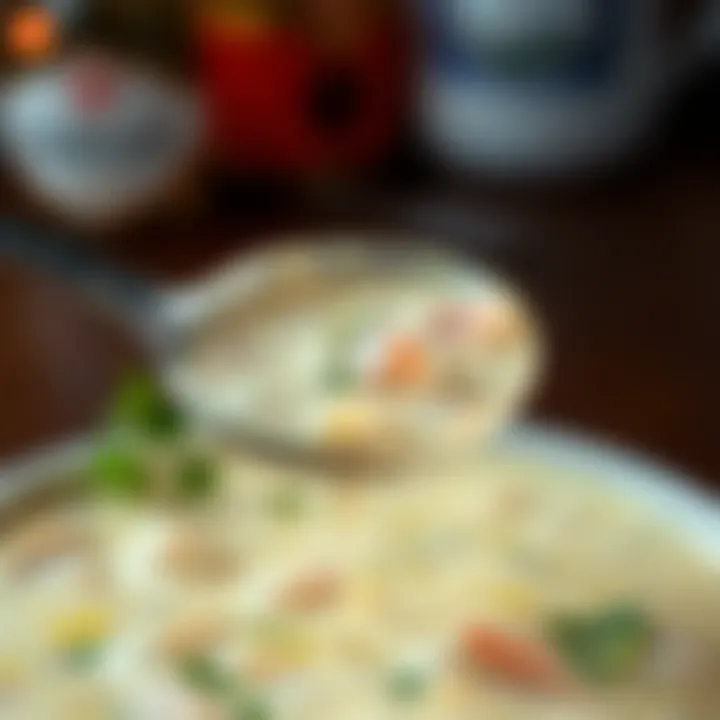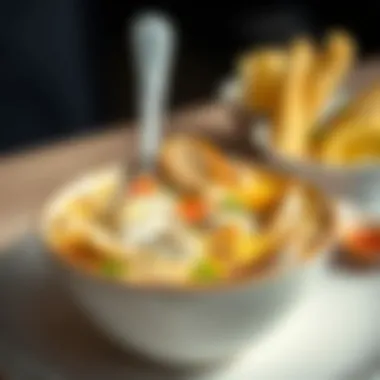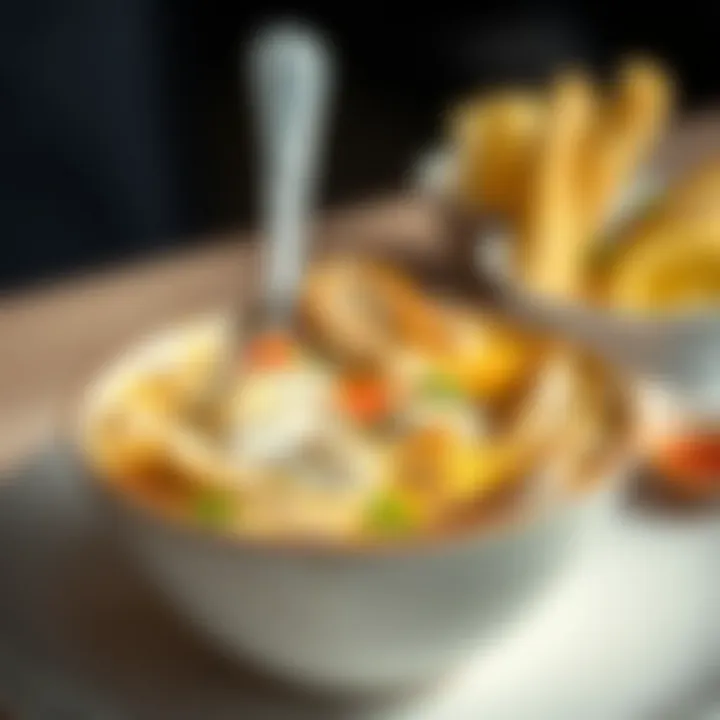A Deep Dive into New England Clam Chowder


Intro
New England clam chowder is more than just a chowder; it is a tradition steeped in history and regional pride. Originating from the northeastern coast of the United States, this thick and creamy soup is celebrated for its harmonious blend of clams, potatoes, onions, and, of course, the key ingredient: rich cream. While many people enjoy a bowl on chilly days, the origins of this beloved dish stretch back to maritime New England, where the age-old practice of gathering clams was a way of life for coastal communities.
As we embark on this exploration, we will uncover the roots of clam chowder, from its inception among fishermen and their families to how it's evolved into various adaptations across the country. Additionally, we will dive into the core ingredients that define this delicacy and share essential tips for crafting a chowder that will make your taste buds dance.
Brace yourself for a culinary journey where every spoonful tells a story. Whether you’re a seasoned chef or a home cook looking to experiment, this guide will equip you with a solid foundation about New England clam chowder, ensuring an appreciation for its craftsmanship. With that said, let’s dip into the recipe overview.
Historical Background
Understanding the historical background of New England clam chowder is crucial for appreciating its significance beyond being just a delicious dish. Clam chowder reflects the region's climatic conditions, its maritime heritage, and a blend of cultures that shaped its ingredients and preparation techniques. Also, the history of this dish provides insights into how local resources and societal changes influence culinary evolution. Not only does this background enhance one’s culinary experience when enjoying chowder, it also grounds the dish in its historical context.
Origins of Clam Chowder
Clam chowder has roots that extend deep into the culinary traditions of the Native American tribes, most notably the Wampanoag, who inhabited coastal regions, where they utilized natural resources effectively. They made clam stews with indigenous ingredients like corn and beans, laying the groundwork for what would eventually evolve into New England clam chowder. When European settlers arrived, they adopted these practices and began to incorporate their own elements, such as dairy and more varied seasonings, blending two worlds into one savory pot. The first documented recipes began surfacing in the 18th century, primarily from cookbooks that emerged in coastal communities.
As time passed, clam chowder became a staple of New England cooking, often served in social settings and gatherings. Its popularity surged in the 19th century, particularly during the whaling era, when sailors sought hearty, nourishing meals that could endure long voyages. Despite variations in the recipe, the use of clams, cream, and potatoes remained consistent, embodying the essence of New England fishing communities.
Evolution Through the Ages
As chowder journeyed through time, it adapted to the tastes and preferences of each generation. The early iterations were often more broth-based, relying heavily on fish stock and occasionally featuring an array of other seafood. With the advent of refrigeration and advancements in cooking technology, the traditional creamy texture groups gained prominence. Home cooks started to replace fishiness with richness, marking a departure from the basic chowders enjoyed by earlier settlers.
In the 20th century, the clam chowder narrative further evolved. The rise of restaurants and dining out led chefs to refine their techniques and present clam chowder as a sophisticated dish. Gourmet versions began to emerge, showcasing not just clams but also a variety of unique ingredients like bacon, herbs, and even exotic spices. The recipe has gone global, with influences seeping in from different cultures that have added their own twist to the dish.
Today, chowder isn't just a meal; it's a cultural artifact. Communities celebrate it with festivals, and it symbolizes a sense of home for many. While each bowl can tell a story that connects the past and the present, it also highlights how a simple dish born from necessity has turned into a beloved tradition enjoyed well beyond the borders of New England.
"Chowder is more than food; it’s a reflection of cultures coming together, embodying a region’s history while always ready for just a little modern twist."
In summary, the historical journey of New England clam chowder is rich with stories of adaptability and community ties. Each spoonful is not merely a taste of the sea, but also a taste of the interconnected narratives of the people who have contributed to this dish through the ages.
Understand the Ingredients
When it comes to New England clam chowder, getting to grips with the ingredients is key. The flavor, texture, and overall experience of this classic dish largely hinge on what you use to make it. Every item plays a role and understanding their contributions can significantly elevate your chowder game. Being aware of what each ingredient brings to the table is important not only for your cooking skills but also for appreciating this delicacy in its entirety.
Types of Clams Used
Clams are the star of the show in any chowder. Typically, quahogs are the go-to choice. Their robust flavor holds up well against cream and other ingredients, making them a popular option. On the other end, littlenecks or cherrystone clams offer a sweeter, more delicate taste. This versatility allows chefs to customize their chowder according to their preferences. Each type imparts a different character to the dish—rich and hearty with quahogs or light and refreshing with littlenecks. It's worth noting that the freshness of the clams is paramount in ensuring a delicious end product, as they account for a significant portion of the chowder's flavor.
Base Ingredients Explained
Potatoes
When you think of chowder, potatoes often spring to mind. They are not only a staple but also a crucial ingredient. The soft, creamy texture of well-cooked potatoes lends a hearty mouthfeel to the soup. Yukon Gold or Russet potatoes are commonly favored because they break down nicely, adding thickness to the chowder. Besides, they absorb flavors beautifully, enhancing the overall taste.
However, be wary—overcooking can lead to mush, which is not ideal for a chowder meant to have a bit of structure.
Onions
Next up are onions, which are essential for building flavor. They contribute a level of sweetness and depth that complements the salty ocean notes from the clams. Most folks lean on yellow onions because their balance of sweetness and sharpness works well. Plus, they caramelize beautifully, adding another layer of flavor. If selected poorly, though, they can be overpowering if raw or not cooked enough, which can disrupt the harmony of the dish.
Celery
Celery might not be the first ingredient that pops into your head, but it does wonders—adding a lovely crunch and a subtle earthiness to the mix. The juice and flavor of fresh celery are crucial for creating a well-rounded chowder. Using fresh stalks rather than the pre-cut ones often produces better results. While some might consider it optional, it truly rounds out the flavor profile if included correctly, though too much can distract from the clam taste.
Seasoning and Flavor Enhancements
Salt and Pepper
Salt and pepper are the unsung heroes of any chowder. They do more than just season; they bring out the natural sweetness of the clams and other ingredients. A carefully measured amount of salt at the right time can elevate the dish immensely. Without sufficient seasoning, a chowder can taste flat and lifeless. When it comes to pepper, freshness is critical; freshly cracked black pepper adds a robust warmth that pairs well with the creaminess of the chowder.


Thyme
Thyme is a wonderful herb to use in chowder, offering a hint of earthiness that balances the richness of the dairy. A few sprigs tossed in can infuse a slight herbal note that complements the other ingredients. Its essence mingles with the clams, providing a depth that's hard to replicate. But caution is essential; too much can overpower the dish and make it taste like a garden rather than a seaside delight.
Bay Leaves
Bay leaves, often added whole during cooking, provide a subtle aromatic flavor that envelopes the chowder with warmth. The trick is to remove them before serving as they can be tough and not particularly pleasant to chew on. Yet, their contribution is noteworthy; they impart a hint of complexity that lingers. It’s a small detail, but sometimes it’s the small things that matter most.
"Well-chosen ingredients are the backbone of a fantastic chowder; they can make or break the dish".
Preparation Techniques
Preparation techniques play a crucial role in the crafting of a rich and hearty New England clam chowder. The method of cooking not only affects the flavor but also the texture, ensuring that every spoonful tells a story of warmth and tradition. Understanding these techniques can elevate a simple chowder recipe into a dish that resonates with authenticity and satisfaction. From the way clams are treated to the timing of each ingredient, careful attention in this phase can make all the difference in achieving that coveted creamy consistency and depth of flavor.
Traditional Cooking Method
The traditional way of preparing New England clam chowder harkens back to its humble roots. Typically, this method involves sweating vegetables like onions, celery, and potatoes in a heavy pot before introducing clams and broth. One important element is the use of fresh clams, which provide a briny clarity to the soup. Starting this way allows the flavors to meld beautifully, enriching the final product.
- Ingredients Setup: The foundational ingredients are key—the chowder begins with a base that usually consists of butter, onion, and celery. This trio, sometimes referred to as a mirepoix, serves to build flavor before the more robust elements are added.
- Layering Flavors: The clams are not the first ingredient in the pot; instead, they come after the veggies have softened and started to caramelize. This layering technique promotes a greater depth of flavor.
- Final Touches: The addition of cream is done towards the end. It’s often the last ingredient that rounds out the meal, imparting a rich finish that’s synonymous with New England chowder.
Traditional recipes also emphasize patience; slow simmering allows delicate flavors to develop and meld, resulting in that velvety texture.
Modern Approaches
With the hustle and bustle of modern life, swift cooking techniques have found their way into the chowder-making process. These modern approaches offer flexibility while still aiming to preserve the dish's beloved characteristics.
Slow Cooker Options
Slow cookers are akin to culinary time machines that allow flavors to develop over several hours with minimal intervention. Utilizing a slow cooker for clam chowder dates back to the rise of slow-cooking popularity but perfectly suits this rich soup.
- Flavor Infusion: One major advantage of using a slow cooker is the ability to let the ingredients infuse over time. The gentle heat extracts flavors and melds them together effortlessly, creating a harmonious chowder.
- Ease of Preparation: You can set it and forget it! Just toss your ingredients and let the slow cooker work its magic. This makes it a popular choice for busy families or gatherings.
- Versatile Cooking: The slow cooker is known for keeping ingredients moist and tender, which is quite beneficial when working with clams. However, a potential downside is that it can sometimes lead to overcooking if left unattended for too long.
Instant Pot Techniques
The Instant Pot has revolutionized home cooking. This electric appliance can create a hearty clam chowder in a fraction of the time needed for traditional cooking methods.
- Speed and Efficiency: With its pressure cooking feature, an Instant Pot reduces cooking times significantly while still preserving those deep flavors. You can go from stovetop to serving in about under 30 minutes.
- Pressure Cooking Benefits: Pressure cooking allows for the tenderization of clams while also ensuring that the vegetables maintain a pleasant texture. It combines the benefits of sautéing and slow cooking without the extensive wait.
- Flavor Preservation: The unique sealing mechanism of the Instant Pot helps retain moisture and enhances the overall flavors. However, the rapid cooking method may sacrifice some depth compared to traditional long-simmered versions.
Overall, choosing between traditional and modern methods depends largely on personal preference and the desired outcome for the chowder. Whether you want to indulge in the rich process of slow cooking or the speed of an Instant Pot, both routes have their merits, contributing to the ever-evolving story of New England clam chowder.
Regional Variations of Clam Chowder
New England clam chowder isn't just one recipe; it's like a culinary mosaic with variations popping up all over the Northeast. These regional variations offer unique flavors and ingredients, reflecting the local palate and cultural influences. Understanding the importance of these variations enriches our appreciation for chowder as a dish. Each type tells a story, illustrating how communities adapt to their climates and resources.
Manhattan Clam Chowder
Unlike its creamy New England cousin, Manhattan clam chowder takes a walk on the wild side with its tomato base. Originating in the bustling streets of New York City, it caught on during the 19th century and quickly became a staple for many locals. The rich red hue of the soup is an inviting contrast to the traditional white, making it an intriguing option for chowder enthusiasts.
Key Characteristics:
- Base Ingredients: Tomato, clams, and various vegetables like carrots and bell peppers.
- Flavor Profile: It leans more towards the savory and tangy side, offering a vibrant taste compared to the creamy atmosphere of New England chowder.
- Cooking Techniques: Often prepared as a quick stew, simmered to meld flavors without too long of a wait.
For those who fancy a lighter take on chowder, the Manhattan version is an excellent option. It highlights the flexibility of chowder as a dish, proving that it can adapt to different cultural influences.
"Manhattan clam chowder serves as a reminder that food evolves with time, much like the bustling city it hails from."
Rhode Island Clam Chowder
Rhode Island clam chowder is often viewed as the middle child between the creamy New England variant and the bold Manhattan type. This version is known for its clear broth, often made from clam juice, allowing the clams' natural flavors to shine brightly in the spotlight.


Key Characteristics:
- Base Ingredients: Clam broth, clams, and minimal vegetables; usually, it keeps things simple with a touch of oregano.
- Flavor Profile: This chowder carries a briny taste, resonating with seafood lovers. The clear broth offers an unadulterated taste of the ocean, making each spoonful refreshing.
- Regional Twist: Often garnished with a dash of hot sauce or a sprinkling of herbs for a unique touch.
Rhode Island's approach to chowder shows that simplicity can also yield magnificence. This variant proves that there’s no one way to make chowder; each region has its nuance, presenting a taste of local customs and traditions.
By exploring these variations, we realize that chowder is more than food; it is an intricate tapestry of history, culture, and community values. Understanding these differences not only adds layers to our culinary knowledge but also brings us closer to the heart of New England's gastronomic identity.
Cultural Significance
Clam chowder occupies more than just a spot on many menus; it represents a rich tapestry of New England culture and heritage. This beloved dish is imbued with stories and traditions, and serves as a communal dish in family gatherings, celebrations, and local events. As we peel back the layers of clam chowder’s significance, we see not only its culinary importance but also its role in unifying communities and preserving regional identity.
Chowder in New England Culture
In New England, clam chowder is often celebrated as a symbol of local pride. Hailing from the coastal areas, this dish brings together ingredients sourced from the very waters surrounding the region. It embodies the direct relationship between the land and the sea, where fishermen and families traditionally relied on the ocean's bounty for sustenance.
- Nostalgia and Memories: For many, clam chowder is interwoven with childhood memories. Weekend trips to the coast often included a warm bowl of chowder that not only warmed the belly but also the heart on chilly sea-side outings. Enthusiasts can often recount their favorite chowder joint and the comforting taste of their family’s recipe as a cherished remnant of the past.
- A Social Connector: Chowder has a unique way of gathering people. In many homes and restaurants, it serves as a starter for family dinners or a main course at social events. It's common to find locals swapping secret recipes, or engaging in friendly debates over which variation reigns supreme.
The dish transcends mere nutrition; it fosters a sense of belonging, revival of traditions, and stories shared over meals.
Chowder Festivals and Competitions
The joy of clam chowder spills over into community celebrations as well, manifesting in festivals and competitions held throughout New England. These events showcase various interpretations of chowder while offering locals and visitors a chance to bond over their love for this culinary treasure.
- Annual Gatherings: Festivals often center around local markets or waterfronts, where participants set up tents and serve their unique chowder recipes. The Chowderfest in Newport, Rhode Island stands out, drawing chowder lovers eager to sample from a variety of vendors. It's not just the taste that counts; creativity and presentation are equally important in a contest that sees eager competitors.
- Community Spirit: During competitions, the sense of camaraderie is palpable. Chefs equip themselves with their family's age-old recipes, and contestants eager to showcase their innovations often work with local farms to source fresh ingredients. The atmosphere buzzes with laughter and anticipation, creating a festival vibe that resonates far beyond mere judging.
These events not only promote the dish but also support local economies and highlight culinary diversity, showcasing how a simple bowl of chowder can bring people together and create lasting memories.
Serving Suggestions
When it comes to New England clam chowder, serving suggestions add a whole new dimension to the dish. They enhance the overall dining experience and allow the chowder’s rich, creamy qualities to shine in different contexts. These suggestions can transform a humble bowl of chowder into something really special, catering to an array of tastes and preferences.
Accompaniments
Crusty Bread
Crusty bread is like the trusty sidekick to a bowl of clam chowder. Its dense geometry provides the perfect vessel for soaking up all the delightful flavors simmering within that creamy concoction. One of the key characteristics of crusty bread is its crispy outer crust paired with a soft, warm interior. This combination not only offers a satisfying texture contrast but also absorbs broth remarkably well.
The crunchy surface creates a lovely tactile experience, encouraging you to break off a piece and dip into the chowder. It's an appealing choice for many because it doesn’t overshadow the chowder's flavor; instead, it complements and enhances the experience. While some may seek a softer roll, opting for crusty bread allows for that satisfying crunch when you savor every sip. Plus, the bread can be homemade or store-bought, making it accessible for everyone.
Clam Fritters
Clam fritters bring an exciting twist when served alongside clam chowder. These delightful morsels add a different texture and flavor profile to the meal; they’re crispy on the outside, tender on the inside, and bursting with clam goodness. The key characteristic of clam fritters is the blend of fresh clams, batter, and spices, which results in a mouthwatering snack that is deliciously decadent.
The unique feature of clam fritters is their ability to be a conversation starter at the dinner table. Pairing them with chowder creates a harmonious dance of flavors that elevates the overall experience. While fritters can be an indulgent addition, they also provide a contrast to the creamy chowder, adding a playful crunch that keeps things interesting.
Presentation Techniques
Presenting clam chowder with flair can make a significant difference in how it is perceived by guests or family. A careful presentation excites the senses before the first spoonful is even enjoyed. Here are some techniques worth considering:
- Garnishes: A sprinkle of freshly chopped chives or a dash of smoked paprika can add a pop of color and burst of flavor.
- Serving Bowls: Choosing rustic bowls made from ceramic or wood enhances that New England vibe. They also provide warmth, both visually and physically.
- Side Displays: Arrange accompaniments like crusty bread and clam fritters on a wooden board next to the chowder.
These methods not only enhance the visual appeal but also encourage a communal dining experience that is tasty and joyful.
Ultimately, it's not just about the chowder itself—it’s about creating memories around it. The right accompaniments and presentation techniques can elevate a simple meal into a special occasion.
By taking the time to consider how to serve your New England clam chowder, you are ensuring that each bowl tells a story of good food and companionship.
Health Considerations


Understanding the health implications of nutrition in clam chowder is vital, especially as dietary preferences evolve. Clam chowder is not just a comfort food; it can offer various health benefits, if considered carefully. The ingredients used in this classic dish, while providing warmth and indulgence, also bring functional nutrition to the table. This article aims to shed light on both the nutritional profile of clam chowder and alternatives for people with specific dietary needs.
Nutritional Aspects
Clam chowder harbors a unique blend of nutrients that makes it not only delicious but also satisfying on a nutritional front. Here are some nutritional highlights:
- Protein Power: Clams are a great source of protein, essential for building and repairing tissues. One cup of clam chowder can pack quite the protein punch, aiding muscle recovery.
- Vitamins and Minerals: Clams are rich in vitamins like B12, which are crucial for nerve function and DNA production. Plus, they contain minerals such as iron and zinc that help in maintaining a healthy immune system.
- Healthy Fats: While traditional recipes may use heavy cream or butter, healthier alternatives can provide essential fatty acids that promote heart health.
However, it’s important to strike a balance, as high sodium levels can be a concern, particularly for those monitoring blood pressure.
Alternatives for Dietary Restrictions
Several dietary trends are shaping how people view chowder. Many are shifting towards gluten-free and dairy-free options, acknowledging the rising number of individuals with intolerances or lifestyle preferences. So, here’s how to keep clam chowder on the table while catering to everyone's needs.
Gluten-Free Options
Gluten-free clam chowder taps into the desire for delicious meals without compromising health. The beauty of this option is evident in its construction: using cornstarch or rice flour instead of traditional flour helps in thickening the soup without gluten.
Key Characteristics: The absence of gluten can lead to a lighter chowder, appealing to those who want something rich, yet easy on the stomach. This alternative not only maintains the classic taste but also opens the dish up for a wider audience, allowing people with celiac disease or gluten sensitivity to indulge without worry.
Advantages: It’s also worth noting that gluten-free options can be made using fresh, whole ingredients, which enhances the overall nutritional value and taste of the chowder. That unique feature allows it to shine while catering to an increasingly health-conscious populace.
Dairy-Free Variations
For those avoiding dairy, especially lactose-intolerant individuals, dairy-free variations bring inclusivity to the table. Substituting coconut milk or almond milk instead of cream not only provides a creamy texture but also offers unique flavors that can enhance the chowder’s overall profile.
Key Characteristics: The richness of coconut milk, for instance, adds a hint of tropical flair, while still making it a hearty dish. Many find dairy-free chowders to be gentler on the digestive system.
Advantages: Moreover, dairy-free versions can be lower in calories than traditional chowder, making it a favorable option for anyone watching their intake. However, one should be cautious of the sodium content in some dairy-free creams that may come pre-packaged, as they can silently escalate overall intake.
"Adapting classics like clam chowder enables a more inclusive dining experience, respecting personal dietary needs while still celebrating the rich taste of tradition."
With these considerations in mind, it's apparent that clam chowder can be modified without sacrificing its essence. Eating with intention can bring both enjoyment and nourishment, ensuring that everyone can join in on savoring this beloved dish.
Creative Twists on Classic Chowder
The world of clam chowder, while steeped in tradition, is not without its room for creativity. This section sheds light on creative twists that elevate this traditional dish, bringing in flavors and techniques from across the globe while honoring its classic roots. These adaptations enrich the experience, making chowder not just a comforting staple but also an inviting canvas for culinary innovation. By exploring these twists, home cooks and professional chefs alike can expand their repertoire and satisfy adventurous palates.
International Influences
The beauty of food lies in its ability to transcend borders and inhabit new cultural contexts. As chowder enthusiasts experiment, they often draw inspiration from international cuisines, creating fusions that both surprise and delight. Here are some remarkable examples of how different culinary traditions influence chowder recipes:
- Asian Inspirations: Incorporating ingredients like miso paste or coconut milk can bring a velvety richness and a hint of umami, making the chowder taste intriguingly different.
- Mediterranean Flavors: By adding olives, sun-dried tomatoes, or feta cheese, cooks can impart a bright, tangy essence, contrasting beautifully with the mildness of the clams.
- Latin Touch: A dash of chipotle powder can introduce a smoky heat, while cilantro and lime enhance the flavors, transforming the chowder into a zesty treat.
Each of these adaptations not only showcases the versatility of clam chowder but also highlights the seamless ways food can share textures and flavors across cultures. The following adaptation serves as a great example of international influences:
"Imagine a New England clam chowder infused with Thai ingredients—coconut milk, lemongrass, and Thai basil—creating a harmony between classic and exotic that dances on the palate."
Incorporating Seasonal Ingredients
Using seasonal ingredients isn’t just a trend; it’s a commitment to freshness and quality. When crafting a chowder, seasonal produce can drastically enhance both flavor and nutrition. Here’s how:
- Spring: Consider adding tender asparagus or peas for a burst of brightness. These greens not only add a pop of color but also provide a fresh crunch that perfectly balances the creaminess of the chowder.
- Summer: In the heat of summer, the addition of corn or zucchini introduces a sweet undertone that plays well with the briny clams. The sweetness of fresh corn particularly complements the flavors present within a chowder.
- Fall: As the leaves turn, root vegetables such as parsnips or butternut squash can contribute an earthy depth. Roasting these vegetables before adding them to the chowder can enhance their natural sweetness and complexity.
- Winter: Hearty greens like kale or collard greens offer not only nutrition but also color and texture during the colder months, boosting the chowder’s comforting qualities.
Bringing in fresh, seasonal produce doesn’t just dentist the dish in a healthy direction; it speaks to the nature of community-oriented cooking. This practice respects traditional methods while also acknowledging the local bounty available at various times throughout the year.
Ending
As we wrap up our exploration of New England clam chowder, it becomes clear that this beloved dish is much more than just a creamy soup; it is a cultural artifact that reflects the history and evolution of New England itself. The clam chowder serves as a gateway into the region’s maritime traditions, connecting us to the fishermen and the coastal communities that have thrived on the abundance of the sea.
This article has touched on various facets of chowder, from its rich origins to the diverse adaptations that different regions have embraced. Understanding these elements can deepen one's appreciation of the dish, transforming each bowl into a narrative of heritage and local pride.
Final Thoughts on New England Clam Chowder
The significance of chowder is not only in its taste but also in its role within communal traditions. Each ingredient tells a story, whether it’s the choice of clams harvested fresh from the Atlantic or the regional spices passed down through generations.
When savoring a bowl of clam chowder, you’re partaking in a shared experience where every spoonful connects you to generations of cooks and food lovers. It’s about warmth, togetherness, and the satisfaction of rich flavors mingling in perfect harmony. Clam chowder invites you to appreciate simplicity while recognizing the artistry behind culinary traditions.















